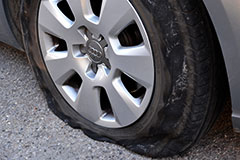Run-flat Tires Explained - Vol.411
There are very few situations that are as annoying to drivers as being stranded on the side of the road with a flat tire. If you've ever been in this situation, you understand how inconvenient and time-consuming it is, since changing a tire can take a lot of time and effort. And in case you don't know how to do it yourself, you may have to wait for roadside assistance, which can make you miss an important event.
Luckily, there is a solution, and it's called a run-flat tire. Although they've been around for quite some time, they've only gained popularity in recent years, so you can find them in a lot of newer car models.

What are Run-flat tires?
Basically, these are tires that will let you drive for another 50 miles or so after your tire is punctured. Of course, you can't drive on them for a very long time, but they should be enough to make sure you get to the closest car shop, or a safe space where you can change your tire. Different tires have different driving limits, so check the manual to see the distance and top speed of each of them.
How Do They Work?
There are two different systems that all flat tires use: the self-supporting system, which is the most common among these tires, and the support ring system.
Self-supporting run-flat tires feature a reinforced sidewall that is thick enough to continue supporting a car in case of air loss. These tires will let you drive for around another 50 miles, at a reasonable speed of around 50 mph.
The support ring system features a ring made out of a sturdy material such as hard rubber that can support the vehicle. Like the other system, this one can only be used in cars that are equipped with Tire Pressure Monitoring System (TPMS).
Pros and Cons
So now that you know how these tires work, let's go over the good and the bad things about them:
Pros:
- Improved mobility - The obvious advantage these tires have is the fact that they let you drive for quite some time after your tire gets punctured. You have enough time to find help without worrying about being left in the middle of the road.
- Stability - Sometimes a sudden loss of tire pressure can affect your ability to drive and maneuver the car. Run-flat tires help with this by preventing drastic maneuverability changes when you get a flat tire.
- Weight - Although they can be a bit heavier due to the in-built systems, they eliminate the need for a spare tire, which lowers the car's weight and leaves more space.
Cons:
- Cost - As you probably might have expected, these tires are a bit pricey compared to traditional tires. You also might need to replace them more often than standard tires, which can also be expensive.
- Availability - As we've said, these tires weren't very popular until recently, which means that they're not that easy to find. Unless you live in a larger city, the availability of these tires may be pretty limited.
- Hard to notice when the tire is low on air - The reinforced sidewall prevents the tire from bloating when it loses air, so unless you notice the run-flat warning, you might drive under-inflated for too long, which can make the tire disintegrate. This is why it's recommended that you use a monitoring system if you have these tires.
The Final Word
Despite a couple of drawbacks, these tires can come in handy in a lot of situations. Some cars have them pre-installed, but you can find a set for your car at some of the more popular car shops, or order them online. They provide safety and convenience, so you can rest assured that a flat tire won't be a big problem anymore.